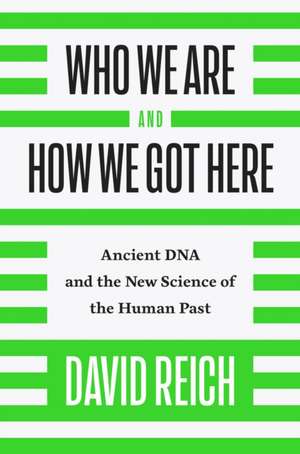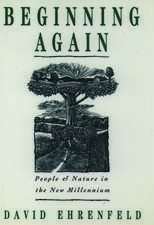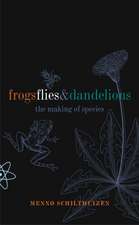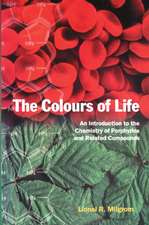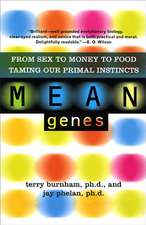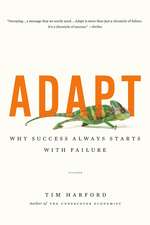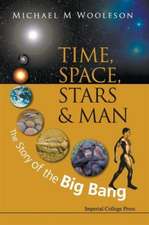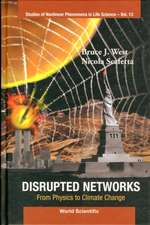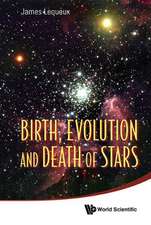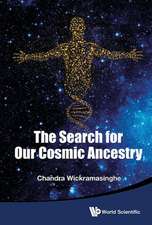Who We Are and How We Got Here
Autor David Reichen Limba Engleză Hardback – 27 mar 2018
| Toate formatele și edițiile | Preț | Express |
|---|---|---|
| Paperback (2) | 68.82 lei 10-16 zile | +24.58 lei 6-10 zile |
| OUP OXFORD – 21 feb 2019 | 68.82 lei 10-16 zile | +24.58 lei 6-10 zile |
| Random House LLC US – 26 feb 2019 | 108.47 lei 3-5 săpt. | +32.98 lei 6-10 zile |
| Hardback (1) | 84.26 lei 24 ore | |
| Knopf Doubleday Publishing Group – 27 mar 2018 | 84.26 lei 24 ore |
Preț: 84.26 lei
Preț vechi: 168.53 lei
-50% Nou
Puncte Express: 126
Preț estimativ în valută:
16.13€ • 16.77$ • 13.37£
16.13€ • 16.77$ • 13.37£
Carte în stoc
Livrare din stoc 26 decembrie
Preluare comenzi: 021 569.72.76
Specificații
ISBN-13: 9781101870327
ISBN-10: 110187032X
Pagini: 368
Dimensiuni: 156 x 235 x 18 mm
Greutate: 0.65 kg
Editura: Knopf Doubleday Publishing Group
ISBN-10: 110187032X
Pagini: 368
Dimensiuni: 156 x 235 x 18 mm
Greutate: 0.65 kg
Editura: Knopf Doubleday Publishing Group
Descriere
Descriere de la o altă ediție sau format:
The past few years have seen a revolution in our ability to map whole genome DNA from ancient humans. With the ancient DNA revolution, combined with rapid genome mapping of present human populations, has come remarkable insights into our past. This important new data has clarified and added to our knowledge from archaeology and anthropology, helped resolve long-existing controversies, challenged long-held views, and thrown up some remarkable surprises.The emerging picture is one of many waves of ancient human migrations, so that all populations existing today are mixes of ancient ones, as well as in many cases carrying a genetic component from Neanderthals, and, in some populations, Denisovans. David Reich, whose team has been at the forefront of these discoveries, explains what the genetics is telling us about ourselves and our complex and often surprising ancestry. Gone are old ideas of any kind of racial 'purity', or even deep and ancient divides between peoples. Instead, we are finding a rich variety of mixtures. Reich describes the cutting-edge findings from the past few years, and also considers the sensitivities involved in tracing ancestry, with science sometimes jostling with politics and tradition. He brings an important wider message: that we should celebrate our rich diversity, and recognize that every one of us is the result of a long history of migration and intermixing of ancient peoples, which we carry as ghosts in our DNA.What will we discover next?
The past few years have seen a revolution in our ability to map whole genome DNA from ancient humans. With the ancient DNA revolution, combined with rapid genome mapping of present human populations, has come remarkable insights into our past. This important new data has clarified and added to our knowledge from archaeology and anthropology, helped resolve long-existing controversies, challenged long-held views, and thrown up some remarkable surprises.The emerging picture is one of many waves of ancient human migrations, so that all populations existing today are mixes of ancient ones, as well as in many cases carrying a genetic component from Neanderthals, and, in some populations, Denisovans. David Reich, whose team has been at the forefront of these discoveries, explains what the genetics is telling us about ourselves and our complex and often surprising ancestry. Gone are old ideas of any kind of racial 'purity', or even deep and ancient divides between peoples. Instead, we are finding a rich variety of mixtures. Reich describes the cutting-edge findings from the past few years, and also considers the sensitivities involved in tracing ancestry, with science sometimes jostling with politics and tradition. He brings an important wider message: that we should celebrate our rich diversity, and recognize that every one of us is the result of a long history of migration and intermixing of ancient peoples, which we carry as ghosts in our DNA.What will we discover next?
Recenzii
A wonderfully illuminating exposition of how advances in reading ancient DNA have upended our ideas about past population movements and human interaction.
Hugely impressive.
Remarkable ... Spectacular ... In making constant new discoveries about humanity, Reich and his Harvard team are now plunging into uncharted academic waters ... Reich's influence in this field has been immense and the output of his department monumental ... Thrilling in its clarity and its scope.
This is a compendious book ... its importance cannot be overstated and neither can some of its best stories.
A thrilling account of mapping humans through time and place ... Reich gives us a window into what ancient DNA can tell us about human evolution, the peopling of the world, continent by continent, and the population mixing that makes us who we are today.
Few subjects fascinate us as much as human origins ... If you want to understand our origins over the course of the last 100,000 years, this book will be the best up-to-date account for you.
The conclusions of this book are reassuringly complex and nuanced. But they are no less approachable, no less captivating for that. Indeed, the result is to bring prehistory almost disarmingly close. He brings whole societies from that past vividly to life.
Gives the first comprehensive account of this newly revealed prehistory ... an astonishing book.
Reich has produced an invaluable resource that is likely to become an enduring intellectual touchstone.
Who We Are and How We Got Here provides a marvellous synthesis of the field.
Geneticists such as Reich have shown [...] that the human world has been made by people who move. This is an important lesson in a time when migration and mobility, in both reality and perception, play such a significant role.
In this comprehensive and provocative book, David Reich exhumes and examines fundamental questions about our origin and future using powerful evidence from human genetics. What does "race" mean in 2018? How alike and how unlike are we? What does identity mean? Reich's book is sobering and clear-eyed, and, in equal part, thrilling and thought provoking. There were times that I had to stand up and clear my thoughts to continue reading this astonishing and important book.
The breakthrough that all archaeologists have been waiting for; a truly exciting account of the way in which ancient DNA is making us rethink prehistory. Essential reading for everyone interested in the past.
David Reich uses the power of modern genome analysis to show the fascinating complexity of human migration and history. By letting the data lead him, he treads a narrow path between racists and xenophobes on one side and left-wing ideologues on the other. Although many of his conclusions will be controversial, he starts a necessary conversation about what modern genome analysis can tell us about the variability of human populations.
This riveting book will blow you away with its rich and astounding account of where we came from and why that matters. Reich tells the surprising story of how humans got to every corner of the planet, which was revealed only after he and other scientists unlocked the secrets of ancient DNA. The courageous, compassionate and highly personal climax will transform how you think about the meaning of ancestry and race.
Who We Are and How We Got Here dramatically revises our understanding of the deep history of our species in our African homeland and beyond. Reich's beautifully written book reads like a detective novel and demonstrates a hard truth that often makes many of us uncomfortable: not only are all human beings mixed, but our intuitive understanding of the evolution of the population structure of the world around us is not to be trusted.
In just five years the study of ancient DNA has transformed our understanding of world prehistory. The geneticist David Reich, one of the pioneers in this field, here gives the brilliantly lucid first account of the resulting new view of human origins and of the later dispersals which went on to shape the modern world.
This book will revolutionize our understanding of human prehistory. David Reich sheds new light on our past from the vantage of a sparkling new discipline-the analysis of ancient DNA. He places migration in the limelight, demonstrating that humans did not just evolve, they spread, often on dramatic scales.
Reich's book isn't just a collection of stories about the histories of human populations. It is a fascinating case study of scientific revolution ... Reich also has interesting things to say about the way his discipline has over the years been caught up in politics.
Whole genome mapping hasn't just revolutionised our world, it has helped us rethink our past.
A hugely important book and essential reading.
The Harvard professor [Reich], who is 43, was recently highlighted by the journal Nature as one of 10 people who mattered in all of science for his role in transforming the field of ancient DNA from "niche pursuit to industrial process".
The work in [Reich's] lab has reshaped our understanding of human prehistory ... He and his colleagues have shed light on the peopling of the planet and the spread of agriculture, among other momentous events.
Reich's intellectual curiosity and passion for research shine through every page of his book ... This book is required reading for everyone interested in an up-to-date account of the spellbinding story of human prehistory.
I learned a good deal from this book, and I encourage others to do the same.
It is an incredibly exciting overview of a revolution in the making.
Who We Are and How We Got Here is both comprehensive and exceptionally well-written ... [a] vast global scope as well as its myriad of fascinating details.
Introduces us to the 21st-century Rosetta Stone: ancient DNA, which will do more for our understanding of prehistory than radiocarbon dating did ... Who We Are and How We Got Here is less than 300 pages of text, but it is packed with startling facts and novel revelations that overturn the conventional expectations of both science and common sense.
Professor David Reich of Harvard Medical School [...] is not a disinterested observer of a fast-developing field; he is a participant and, in fact, a driver, of the ancient DNA revolution and it is his and his team's research that has accomplished much of the reshaping of human history. So this book has the feel of a first-hand account from the trenches that also carries with it a high-level perspective of what is going on where and why.
David Reich's magisterial book is a riveting account of human pre-history and history, through the new lens provided by ancient DNA data. The story of human populations, as he shows, is ever one of widespread, repeated mixing, debunking the fiction of a "pure" population.
Powerful writing and extraordinary insights animate this endlessly fascinating account, by a world scientific leader, of who we modern humans are and how our ancestors arrived in the diverse corners of the world. I could not put the book down.
Reich's book reads like notes from the frontline of the 'Ancient DNA Revolution' with all the spellbinding drama and intrigue that comes with such a huge transformation in our understanding of human history.
Hugely impressive.
Remarkable ... Spectacular ... In making constant new discoveries about humanity, Reich and his Harvard team are now plunging into uncharted academic waters ... Reich's influence in this field has been immense and the output of his department monumental ... Thrilling in its clarity and its scope.
This is a compendious book ... its importance cannot be overstated and neither can some of its best stories.
A thrilling account of mapping humans through time and place ... Reich gives us a window into what ancient DNA can tell us about human evolution, the peopling of the world, continent by continent, and the population mixing that makes us who we are today.
Few subjects fascinate us as much as human origins ... If you want to understand our origins over the course of the last 100,000 years, this book will be the best up-to-date account for you.
The conclusions of this book are reassuringly complex and nuanced. But they are no less approachable, no less captivating for that. Indeed, the result is to bring prehistory almost disarmingly close. He brings whole societies from that past vividly to life.
Gives the first comprehensive account of this newly revealed prehistory ... an astonishing book.
Reich has produced an invaluable resource that is likely to become an enduring intellectual touchstone.
Who We Are and How We Got Here provides a marvellous synthesis of the field.
Geneticists such as Reich have shown [...] that the human world has been made by people who move. This is an important lesson in a time when migration and mobility, in both reality and perception, play such a significant role.
In this comprehensive and provocative book, David Reich exhumes and examines fundamental questions about our origin and future using powerful evidence from human genetics. What does "race" mean in 2018? How alike and how unlike are we? What does identity mean? Reich's book is sobering and clear-eyed, and, in equal part, thrilling and thought provoking. There were times that I had to stand up and clear my thoughts to continue reading this astonishing and important book.
The breakthrough that all archaeologists have been waiting for; a truly exciting account of the way in which ancient DNA is making us rethink prehistory. Essential reading for everyone interested in the past.
David Reich uses the power of modern genome analysis to show the fascinating complexity of human migration and history. By letting the data lead him, he treads a narrow path between racists and xenophobes on one side and left-wing ideologues on the other. Although many of his conclusions will be controversial, he starts a necessary conversation about what modern genome analysis can tell us about the variability of human populations.
This riveting book will blow you away with its rich and astounding account of where we came from and why that matters. Reich tells the surprising story of how humans got to every corner of the planet, which was revealed only after he and other scientists unlocked the secrets of ancient DNA. The courageous, compassionate and highly personal climax will transform how you think about the meaning of ancestry and race.
Who We Are and How We Got Here dramatically revises our understanding of the deep history of our species in our African homeland and beyond. Reich's beautifully written book reads like a detective novel and demonstrates a hard truth that often makes many of us uncomfortable: not only are all human beings mixed, but our intuitive understanding of the evolution of the population structure of the world around us is not to be trusted.
In just five years the study of ancient DNA has transformed our understanding of world prehistory. The geneticist David Reich, one of the pioneers in this field, here gives the brilliantly lucid first account of the resulting new view of human origins and of the later dispersals which went on to shape the modern world.
This book will revolutionize our understanding of human prehistory. David Reich sheds new light on our past from the vantage of a sparkling new discipline-the analysis of ancient DNA. He places migration in the limelight, demonstrating that humans did not just evolve, they spread, often on dramatic scales.
Reich's book isn't just a collection of stories about the histories of human populations. It is a fascinating case study of scientific revolution ... Reich also has interesting things to say about the way his discipline has over the years been caught up in politics.
Whole genome mapping hasn't just revolutionised our world, it has helped us rethink our past.
A hugely important book and essential reading.
The Harvard professor [Reich], who is 43, was recently highlighted by the journal Nature as one of 10 people who mattered in all of science for his role in transforming the field of ancient DNA from "niche pursuit to industrial process".
The work in [Reich's] lab has reshaped our understanding of human prehistory ... He and his colleagues have shed light on the peopling of the planet and the spread of agriculture, among other momentous events.
Reich's intellectual curiosity and passion for research shine through every page of his book ... This book is required reading for everyone interested in an up-to-date account of the spellbinding story of human prehistory.
I learned a good deal from this book, and I encourage others to do the same.
It is an incredibly exciting overview of a revolution in the making.
Who We Are and How We Got Here is both comprehensive and exceptionally well-written ... [a] vast global scope as well as its myriad of fascinating details.
Introduces us to the 21st-century Rosetta Stone: ancient DNA, which will do more for our understanding of prehistory than radiocarbon dating did ... Who We Are and How We Got Here is less than 300 pages of text, but it is packed with startling facts and novel revelations that overturn the conventional expectations of both science and common sense.
Professor David Reich of Harvard Medical School [...] is not a disinterested observer of a fast-developing field; he is a participant and, in fact, a driver, of the ancient DNA revolution and it is his and his team's research that has accomplished much of the reshaping of human history. So this book has the feel of a first-hand account from the trenches that also carries with it a high-level perspective of what is going on where and why.
David Reich's magisterial book is a riveting account of human pre-history and history, through the new lens provided by ancient DNA data. The story of human populations, as he shows, is ever one of widespread, repeated mixing, debunking the fiction of a "pure" population.
Powerful writing and extraordinary insights animate this endlessly fascinating account, by a world scientific leader, of who we modern humans are and how our ancestors arrived in the diverse corners of the world. I could not put the book down.
Reich's book reads like notes from the frontline of the 'Ancient DNA Revolution' with all the spellbinding drama and intrigue that comes with such a huge transformation in our understanding of human history.
Notă biografică
David Reich is a Professor of Genetics at Harvard University and a Howard Hughes Medical Institute Investigator. In 2015 he was highlighted by Nature magazine as one of "10 people who matter" in all of science for his role in transforming the field of ancient DNA "from niche pursuit to industrial process." In 2017 he was awarded the Dan David Prize in the Archaeological and Natural Sciences for the computational discovery of intermixing between Neanderthals and modern humans.
Cuprins
Acknowledgments
Introduction
Part I The Deep History of Our Species
1 How the Genome Explains Who We Are
2 Encounters with Neanderthals
3 Ancient DNA Opens the Floodgates
Part II How We Got to Where We Are Today
4 Humanity’s Ghosts
5 The Making of Modern Europe
6 The Collision That Formed India
7 In Search of Native American Ancestors
8 The Genomic Origins of East Asians
9 Rejoining Africa to the Human Story
Part III The Disruptive Genome
10 The Genomics of Inequality
11 The Genomics of Race and Identity
12 The Future of Ancient DNA
Notes on the Illustrations
Notes
Index
Introduction
Part I The Deep History of Our Species
1 How the Genome Explains Who We Are
2 Encounters with Neanderthals
3 Ancient DNA Opens the Floodgates
Part II How We Got to Where We Are Today
4 Humanity’s Ghosts
5 The Making of Modern Europe
6 The Collision That Formed India
7 In Search of Native American Ancestors
8 The Genomic Origins of East Asians
9 Rejoining Africa to the Human Story
Part III The Disruptive Genome
10 The Genomics of Inequality
11 The Genomics of Race and Identity
12 The Future of Ancient DNA
Notes on the Illustrations
Notes
Index
